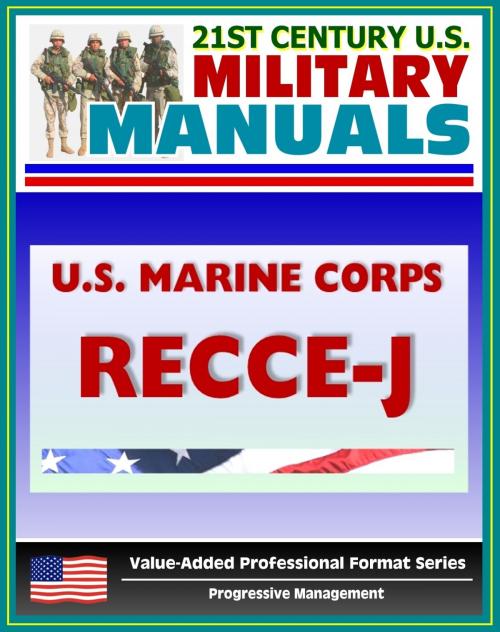21st Century U.S. Military Manuals: U.S. Marine Corps (USMC) RECCE-J, Multiservice Procedures for Requesting Reconnaissance Information in a Joint Environment - MCRP 2-2.1
Nonfiction, History, Military, Naval, United States| Author: | Progressive Management | ISBN: | 9781465783011 |
| Publisher: | Progressive Management | Publication: | February 16, 2012 |
| Imprint: | Smashwords Edition | Language: | English |
| Author: | Progressive Management |
| ISBN: | 9781465783011 |
| Publisher: | Progressive Management |
| Publication: | February 16, 2012 |
| Imprint: | Smashwords Edition |
| Language: | English |
Part of our value-added professional format series of U.S. military manuals, this U.S. Marine Corps manual covers procedures for requesting reconnaissance information in a joint environment.
This publication explains reconnaissance and the intelligence cycle; describes reconnaissance products; and, most importantly, demonstrates how to use and prepare formats for reconnaissance requests. It also explains the reconnaissance request flow and includes appendices which explain in detail reconnaissance types, capabilities, and limitations; intelligence support to joint operations; and detailed instructions for two additional key reconnaissance request formats. To facilitate field use, full page-sized request format blanks are included (users can laminate or reproduce these formats, and their accompanying instructions, for use in mission planning guides, personal checklists, etc.).
The purpose of this publication is threefold. It is designed to help users (1) employ established joint procedures, (2) better articulate reconnaissance and intelligence requirements, and (3) derive full utility from the products they receive.
As a bonus, this reproduction includes the Marine Corps Manual, the basic publication of the United States Marine Corps issued by the Commandant of the Marine Corps and approved by the Secretary of the Navy - sold separately for $7.99. It is a regulatory publication for the Department of the Navy as defined in U.S. Navy Regulations. The Marine Corps Manual is designed primarily for use by Marine Corps commanders and their staffs, Navy officers exercising command over Marines, the staff of the Commandant of the Marine Corps, and the staffs of the bureaus and offices of the Navy Department. Contents: Chapter 1 - General Administration And Management * Chapter 2 - Manpower * Chapter 3 - Operations And Readiness * Chapter 4 - Logistics
The manual describes the Marine Corps mission and functions: The Marine Corps shall be organized, trained, and equipped to: (1) Provide Fleet Marine Forces of combined arms, together with supporting air components, for service with the United States Fleet in the seizure or defense of advanced naval bases and for the conduct of such land operations as may be essential to the prosecution of a naval campaign. (2) Provide detachments and organizations for service on armed vessels of the Navy, and security detachments for the protection of naval property at naval stations and bases. (3) Develop, in coordination with the Army, Navy, and Air Force, the doctrines, tactics, techniques, and equipment employed by landing forces in amphibious operations. The Marine Corps shall have primary interest in the development of those landing force doctrines, tactics, techniques, and equipment which are of common interest to the Army and the Marine Corps.
Part of our value-added professional format series of U.S. military manuals, this U.S. Marine Corps manual covers procedures for requesting reconnaissance information in a joint environment.
This publication explains reconnaissance and the intelligence cycle; describes reconnaissance products; and, most importantly, demonstrates how to use and prepare formats for reconnaissance requests. It also explains the reconnaissance request flow and includes appendices which explain in detail reconnaissance types, capabilities, and limitations; intelligence support to joint operations; and detailed instructions for two additional key reconnaissance request formats. To facilitate field use, full page-sized request format blanks are included (users can laminate or reproduce these formats, and their accompanying instructions, for use in mission planning guides, personal checklists, etc.).
The purpose of this publication is threefold. It is designed to help users (1) employ established joint procedures, (2) better articulate reconnaissance and intelligence requirements, and (3) derive full utility from the products they receive.
As a bonus, this reproduction includes the Marine Corps Manual, the basic publication of the United States Marine Corps issued by the Commandant of the Marine Corps and approved by the Secretary of the Navy - sold separately for $7.99. It is a regulatory publication for the Department of the Navy as defined in U.S. Navy Regulations. The Marine Corps Manual is designed primarily for use by Marine Corps commanders and their staffs, Navy officers exercising command over Marines, the staff of the Commandant of the Marine Corps, and the staffs of the bureaus and offices of the Navy Department. Contents: Chapter 1 - General Administration And Management * Chapter 2 - Manpower * Chapter 3 - Operations And Readiness * Chapter 4 - Logistics
The manual describes the Marine Corps mission and functions: The Marine Corps shall be organized, trained, and equipped to: (1) Provide Fleet Marine Forces of combined arms, together with supporting air components, for service with the United States Fleet in the seizure or defense of advanced naval bases and for the conduct of such land operations as may be essential to the prosecution of a naval campaign. (2) Provide detachments and organizations for service on armed vessels of the Navy, and security detachments for the protection of naval property at naval stations and bases. (3) Develop, in coordination with the Army, Navy, and Air Force, the doctrines, tactics, techniques, and equipment employed by landing forces in amphibious operations. The Marine Corps shall have primary interest in the development of those landing force doctrines, tactics, techniques, and equipment which are of common interest to the Army and the Marine Corps.















